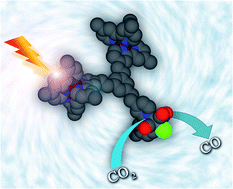当前位置:
X-MOL 学术
›
Chem. Sci.
›
论文详情
Our official English website, www.x-mol.net, welcomes your
feedback! (Note: you will need to create a separate account there.)
Efficient trinuclear Ru(ii)-Re(i) supramolecular photocatalysts for CO2 reduction based on a new tris-chelating bridging ligand built around a central aromatic ring.
Chemical Science ( IF 7.6 ) Pub Date : 2019-12-14 , DOI: 10.1039/c9sc04532e Ambra M Cancelliere 1 , Fausto Puntoriero 1 , Scolastica Serroni 1 , Sebastiano Campagna 1 , Yusuke Tamaki 2 , Daiki Saito 2 , Osamu Ishitani 2
Chemical Science ( IF 7.6 ) Pub Date : 2019-12-14 , DOI: 10.1039/c9sc04532e Ambra M Cancelliere 1 , Fausto Puntoriero 1 , Scolastica Serroni 1 , Sebastiano Campagna 1 , Yusuke Tamaki 2 , Daiki Saito 2 , Osamu Ishitani 2
Affiliation

|
We have designed and synthesized a new tris-chelating polypyridine ligand (bpy3Ph) suitable to be used as a bridging ligand (BL) for constructing various supramolecular photocatalysts. This BL is a phenylene ring with three ethylene chains at 1, 3, and 5 positions, of which the other terminals are connected to 2,2'-bipyridine moieties. The ligand bpy3Ph has been used to prepare, according to a multi-step synthetic protocol, trinuclear supramolecular photocatalysts containing different metal subunits. In particular, the compounds Ru2Re and RuRe2 have been prepared, containing different ratios of components based on Ru(dmb)3 2+-type and Re(dmb)(CO)3Cl-type units (dmb = 4,4'-dimethyl-2,2'-bipyridine), which can play the roles of photosensitizers and catalyst units for photocatalytic CO2 reduction, respectively. The trinuclear model Ru3 and mononuclear and dinuclear Ru and Ru2 precursor metal complexes, containing free chelating sites, have also been synthesized using the same bridging ligand. The absorption spectra, redox behaviour and photophysical properties of the new species indicate that there is no strong electronic interaction among the Ru and Re units. The trinuclear complexes Ru2Re and RuRe2 could photocatalyze CO2 reduction to CO with high selectivity (up to 97%), high efficiency (Φ COs of 28% and 25%, respectively: BIH as a reductant), and high durability (TONCOs of 5232 and 6038, respectively: BIH as a reductant) which are the largest TONs for CO2 reduction using supramolecular photocatalysts in homogeneous solutions. The absence of negligible accumulation of the mono-reduced form of the photosensitizer indicates fast electron transfer to the catalyst unit(s) through the relatively large bridging ligand and is proposed to contribute to the outstanding photocatalytic properties of the new species, including their durability. The relevant photocatalytic behaviour of the new systems indicates new avenues for the design of extended bridging ligands capable of efficiently and functionally integrating photosensitizers and catalysts towards the preparation of new, larger supramolecular photocatalysts for selective CO2 reduction.
中文翻译:

高效三核Ru(ii)-Re(i)超分子光催化剂可基于围绕中心芳环的新型三螯合桥连配体来减少CO2。
我们已经设计并合成了一种新的三螯合聚吡啶配体(bpy3Ph),适合用作构建各种超分子光催化剂的桥连配体(BL)。该BL是在1、3和5位具有三个乙烯链的亚苯基环,其其他末端连接至2,2'-联吡啶部分。根据多步合成方案,配体bpy3Ph已用于制备含有不同金属亚基的三核超分子光催化剂。特别地,已经制备了化合物Ru 2 Re和RuRe 2,其包含基于Ru(dmb)3 2+型和Re(dmb)(CO)3 Cl型单元(dmb = 4,4′-二甲基-)的不同比例的组分。 2,2'-联吡啶),分别可以发挥光敏剂和光催化还原CO2的催化剂单元的作用。还使用相同的桥连配体合成了三核模型Ru3以及含有游离螯合位点的单核和双核Ru和Ru2前体金属络合物。新物种的吸收光谱,氧化还原行为和光物理性质表明,Ru和Re单元之间没有强烈的电子相互作用。三核配合物Ru2Re和RuRe2可以以高选择性(高达97%),高效率(ΦCO分别为28%和25%:BIH作为还原剂)和高耐久性(TONCO为5232和5%)的光催化方式将CO2还原为CO。分别为6038:BIH作为还原剂),这是在均相溶液中使用超分子光催化剂进行CO2还原的最大TON。光敏剂单还原形式的累积量可忽略不计表明电子通过相对较大的桥连配体快速转移至催化剂单元,并被提议为新物质的出色光催化性能做出贡献,包括其持久性。新系统的相关光催化行为为扩展桥联配体的设计提供了新途径,该桥联配体能够有效地和功能上整合光敏剂和催化剂,以制备用于选择性还原CO2的新型更大分子超光催化剂。
更新日期:2020-02-13
中文翻译:

高效三核Ru(ii)-Re(i)超分子光催化剂可基于围绕中心芳环的新型三螯合桥连配体来减少CO2。
我们已经设计并合成了一种新的三螯合聚吡啶配体(bpy3Ph),适合用作构建各种超分子光催化剂的桥连配体(BL)。该BL是在1、3和5位具有三个乙烯链的亚苯基环,其其他末端连接至2,2'-联吡啶部分。根据多步合成方案,配体bpy3Ph已用于制备含有不同金属亚基的三核超分子光催化剂。特别地,已经制备了化合物Ru 2 Re和RuRe 2,其包含基于Ru(dmb)3 2+型和Re(dmb)(CO)3 Cl型单元(dmb = 4,4′-二甲基-)的不同比例的组分。 2,2'-联吡啶),分别可以发挥光敏剂和光催化还原CO2的催化剂单元的作用。还使用相同的桥连配体合成了三核模型Ru3以及含有游离螯合位点的单核和双核Ru和Ru2前体金属络合物。新物种的吸收光谱,氧化还原行为和光物理性质表明,Ru和Re单元之间没有强烈的电子相互作用。三核配合物Ru2Re和RuRe2可以以高选择性(高达97%),高效率(ΦCO分别为28%和25%:BIH作为还原剂)和高耐久性(TONCO为5232和5%)的光催化方式将CO2还原为CO。分别为6038:BIH作为还原剂),这是在均相溶液中使用超分子光催化剂进行CO2还原的最大TON。光敏剂单还原形式的累积量可忽略不计表明电子通过相对较大的桥连配体快速转移至催化剂单元,并被提议为新物质的出色光催化性能做出贡献,包括其持久性。新系统的相关光催化行为为扩展桥联配体的设计提供了新途径,该桥联配体能够有效地和功能上整合光敏剂和催化剂,以制备用于选择性还原CO2的新型更大分子超光催化剂。











































 京公网安备 11010802027423号
京公网安备 11010802027423号